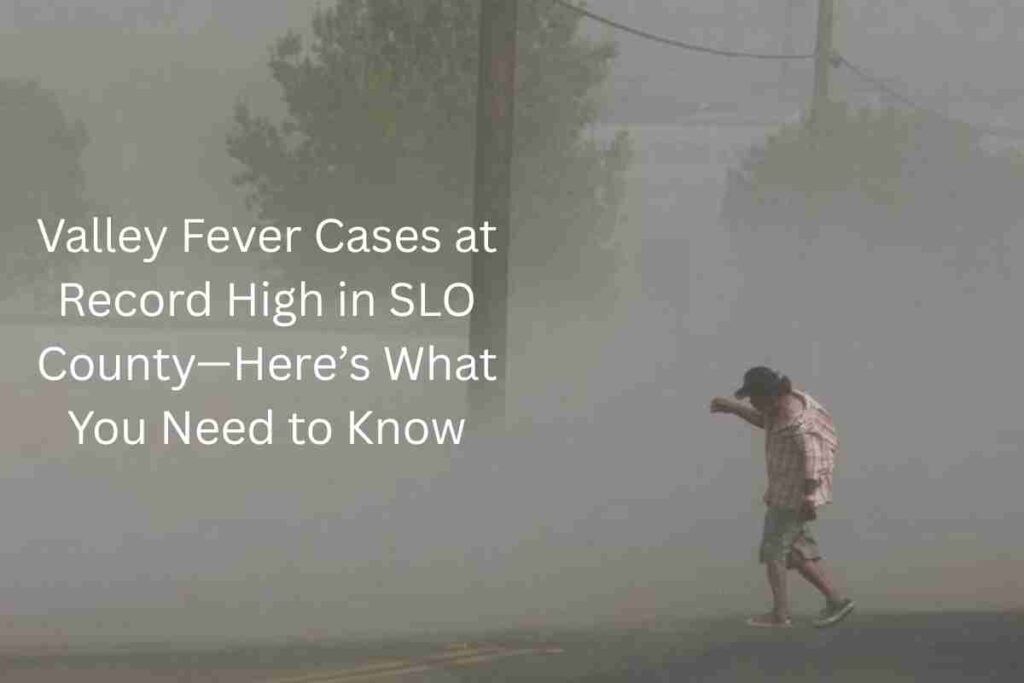Valley Fever cases hit an all-time high in San Luis Obispo (SLO) County last year, with health officials reporting a staggering 482 cases in 2024. That’s nearly double the 244 cases logged in 2023, and higher than the previous record of 445 cases in 2017. While this alarming trend isn’t unexpected, it’s an important wake-up call for residents to understand the risks and take steps to protect themselves.
This blog will guide you through what Valley Fever is, how it spreads, why cases are on the rise, and what you can do to reduce your risk.
What Is Valley Fever?
Valley Fever, also known as coccidioidomycosis, is a fungal infection caused by Coccidioides, a fungus that lives in soil. It is endemic to certain areas of the United States, including California’s SLO County, the Central Valley, and the Southwest.
When soil containing fungal spores is disturbed—by wind, digging, or even driving—the spores can become airborne. People (and animals) may unknowingly breathe in the spores, leading to infection.
“About 60% of people who are infected won’t show symptoms,” according to the SLO County Public Health Department. However, 30-40% may develop flu-like symptoms, and in severe cases (about 1%), the disease can spread to other areas of the body, causing serious health complications.
Why Are Valley Fever Cases Increasing?
The spike in Valley Fever cases in SLO County may be attributed to climatic conditions.
Health Officer Dr. Penny Borenstein explains, “fever is known to increase after periods of drought followed by heavy rain.”
Here’s why:
- Periods of Drought: Years of dry weather allow the fungus to multiply in the soil.
- Heavy Rain: Rain encourages fungal growth.
- Windy Weather: After the rain, strong winds or construction work stir up the soil, sending spores into the air.
San Luis Obispo’s geography and climate make it particularly susceptible to these weather cycles, which intensify the spread of the fungus.
Symptoms of Valley Fever
If you’ve been exposed to Coccidioides, you might experience symptoms similar to the flu, including:
- Persistent cough
- Fever
- Fatigue
- Chest pain
- Body aches
- Night sweats
Symptoms usually appear 1-3 weeks after exposure. While most cases resolve on their own, prolonged symptoms should prompt a visit to your healthcare provider.
Tip: If you’ve had flu-like symptoms lasting more than a few weeks, ask your doctor about testing for Fever. Early diagnosis can prevent complications.
How to Reduce Your Risk
Completely avoiding exposure to dirt and dust is almost impossible, but you can take steps to lower your risk of contracting Fever:
1. Avoid Dusty Environments
- Stay indoors during windy days when dust levels are high.
- If you need to be outdoors, especially in dusty areas, wear an N95 mask for added protection.
2. Reduce Soil Disturbance
- Dampen soil before digging to minimize the amount of dust released into the air.
3. Adjust Vehicle Settings
- When driving through areas with visible dust, roll up your windows and set your air conditioning to recirculate.
4. Protect Your Pets
- Dogs, cats, and horses can also inhale fungal spores. Monitor them for symptoms, like lethargy or coughing, and consult a vet if needed.
Is Valley Fever Contagious?
No, Valley Fever is not contagious. You cannot catch it from another person or animal. However, pets, like humans, can contract the disease when they inhale airborne spores.
What to Do If You Suspect Valley Fever
If you think you or a loved one might have Fever, take the following steps:
- Consult a Healthcare Provider
Share any symptoms you’ve been experiencing and discuss your possible exposure to dust or soil in affected areas. Request a test for Valley Fever, if needed.
- Monitor Symptoms
Most cases clear up on their own, but severe symptoms—like difficulty breathing, weight loss, or prolonged fatigue—could indicate complications requiring treatment.
- Follow Treatment Plans
For more serious cases, antifungal medications may be prescribed to manage the infection.
SLO County’s Response to Valley Fever
SLO County officials have ramped up efforts to spread awareness about Valley Fever. Healthcare providers have been urged to be vigilant in diagnosing the infection, and public health campaigns are educating residents about risk factors and prevention strategies.
Dr. Borenstein reassures the community, stating, “We’ve been working to ensure our healthcare providers and community know to be on the lookout for this disease and know how to reduce your risk.”
Valley Fever in Numbers
Here’s a quick look at how Fever cases have increased in SLO County over the years:
- 2024: 482 cases
- 2023: 244 cases
- 2017 (previous record high): 445 cases
These numbers highlight the urgent need for awareness and prevention in the region.
Take It Seriously but Stay Prepared
Valley Fever may sound like a tricky foe, but with the right precautions and awareness, it doesn’t have to disrupt your life. Staying informed and proactive is the best way to protect your health and the well-being of your loved ones.
For more information about Valley Fever, visit the SLO County Public Health Department’s website. If you think you’ve been exposed, reach out to your healthcare provider early for guidance.
Meta Data
Meta title
Valley Fever Cases Hit Record High in SLO County
Meta description
Learn why Valley Fever cases are rising in San Luis Obispo County, how to recognize symptoms, and the steps you can take to protect yourself.
